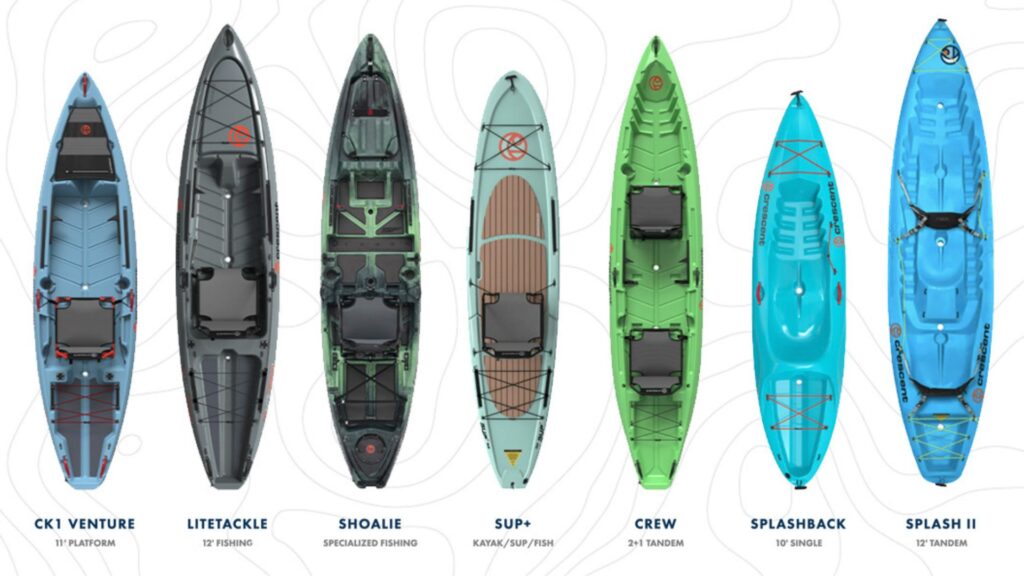When embarking on a kayaking adventure, one of the fundamental questions to consider is, How much does a kayak weigh? The weight of a kayak is a crucial factor that affects not only the ease of transportation but also the performance on the water. Whether you’re a seasoned paddler or a beginner, understanding the importance of kayak weight can significantly enhance your experience.
Kayaks come in a variety of weights, which can range from lightweight models that are easy to carry and maneuver, to heavier ones that offer more stability and durability. The material of the kayak, its size, and its design all play a part in determining its weight. Typically, a standard recreational kayak weighs between 20 to 35 kilograms (44 to 77 pounds), while specialized touring or sea kayaks may weigh more.
The weight of the kayak also influences its maximum capacity, which is the total weight it can safely support. This includes not only the paddler’s weight but also any additional gear or supplies. Therefore, when selecting a kayak, it’s essential to consider both the kayak’s weight and its weight capacity to ensure a safe and enjoyable outing.
In this article, we’ll delve into the various aspects of kayak weight, from the factors that contribute to it, to how it impacts the kayaking experience. We’ll also provide tips on choosing the right kayak for your needs and how to handle different kayak weights effectively. So, let’s set sail into the world of kayaks and explore the significance of their weight.
- Factors that Influence Kayak Weight
- What factors influence the weight of a kayak?
- How much does an average kayak weigh?
- Are there lightweight kayaks available for easy transportation?
- Do heavier kayaks offer more stability and durability?
- How do I determine the weight capacity of a kayak?
- What are some tips for handling and transporting heavy kayaks?
- Can you recommend some popular lightweight kayak models?
- Are there common misconceptions about kayak weight?
Factors that Influence Kayak Weight
The weight of a kayak is not a fixed number; it varies based on several factors that contribute to the overall mass and usability of the vessel. Understanding these factors is essential for anyone looking to purchase a kayak that fits their needs, whether for leisure, sport, or adventure. Here are the main elements that influence how much a kayak weighs:
Material: The construction material of a kayak is the most significant factor affecting its weight. Common materials include polyethylene, fiberglass, Kevlar, and carbon fiber, each with different weight implications. Polyethylene is durable and affordable but heavier. Fiberglass offers a good balance between weight and performance, while Kevlar and carbon fiber are premium materials that are both lightweight and strong.
Size and Shape: The dimensions of a kayak directly impact its weight. Longer and narrower kayaks tend to be lighter and faster, while shorter and wider models offer more stability but increase the weight. The shape also plays a role; for example, a sit-on-top kayak will generally weigh more than a comparable sit-inside model due to additional material used for the open deck design.
Features and Accessories: Additional features and accessories can add significant weight to a kayak. Seats, storage hatches, rod holders, and pedal systems are common additions that increase weight. The more features a kayak has, the heavier it will likely be.
Type of Kayak: The intended use of the kayak also dictates its weight. Recreational kayaks are usually lighter and designed for easy handling. In contrast, touring or sea kayaks are built for long-distance travel and are often heavier due to their size and the need for extra features for comfort and storage.
Understanding Different Types of Kayaks and Their Weight Ranges

Kayaking is a versatile activity that caters to various preferences, from serene paddles in calm waters to adrenaline-fueled rides in challenging rapids. The type of kayak you choose will significantly influence your experience, and understanding the different types and their weight ranges is essential for making an informed decision.
Recreational Kayaks: These are the most common kayaks, designed for casual paddling in calm waters. They are generally wider, providing more stability, which makes them ideal for beginners. Recreational kayaks are typically made from polyethylene, making them durable but also heavier. They can weigh between 20 to 60 pounds.
Touring Kayaks: Built for longer distances and often used in open waters like lakes and coastal areas, touring kayaks are longer and narrower, which helps in tracking straight and increasing speed. They are usually constructed with lighter materials such as fiberglass or thermoformed plastics, weighing approximately 40 to 60 pounds.
Fishing Kayaks: These kayaks are equipped with features like rod holders, gear tracks, and storage options for tackle and catches. They are often heavier due to these added features and the need for greater stability while fishing. Fishing kayaks can weigh between 35 to 100 pounds, depending on their construction and features.
Tandem Kayaks: Designed to accommodate two or more paddlers, tandem kayaks are longer and can be heavier. They offer a shared paddling experience and can range in weight from 50 to 100 pounds.
Inflatable Kayaks: Known for their portability and ease of storage, inflatable kayaks are the lightest option. They can be made from PVC or Hypalon, and despite their lightweight nature, they are surprisingly durable. Inflatable kayaks typically weigh between 20 to 40 pounds.
Performance Kayaks: These kayaks, including racing and sea kayaks, are designed for speed and efficiency. They are often made from ultra-lightweight materials like carbon fiber or Kevlar and can weigh as little as 20 pounds or up to 50 pounds for more robust models.
Lightweight Kayaks for Easy Transportation

For many kayakers, the weight of the kayak is a primary concern, especially when it comes to transportation. Lightweight kayaks offer the advantage of being easier to carry, load, and launch, making them a popular choice for those who value convenience and ease of use. Here’s what you need to know about lightweight kayaks for easy transportation:
Materials and Construction: Lightweight kayaks are often made from advanced materials such as carbon fiber or ultra-light plastics that reduce weight without compromising durability. The construction techniques used can also affect weight, with some kayaks featuring thinner hulls or hollow sections to lessen the load.
Portability Features: Many lightweight kayaks come equipped with features designed to make transportation easier. This includes built-in carry handles, lighter and more compact paddles, and sometimes even a wheeled transport system. Some models are also designed to be disassembled or folded, which can be a significant advantage when space is limited.
Inflatable Options: Inflatable kayaks are a subcategory of lightweight kayaks that are particularly easy to transport. They can be deflated and packed into a carry bag, making them ideal for those with limited storage space or for transporting in a small vehicle. When inflated, they are surprisingly sturdy and can offer a comfortable and stable ride.
Performance Considerations: While lightweight kayaks are easier to transport, it’s important to consider how the weight affects performance. Lighter kayaks may be more susceptible to wind and may not track as well as heavier models. However, for calm waters and short distances, the ease of transportation can outweigh these considerations.
Heavy-Duty Kayaks for Stability and Durability

Heavy-duty kayaks are the workhorses of the kayak world, designed to offer stability and durability in various water conditions. These robust vessels are ideal for paddlers who prioritize a stable platform for activities like fishing, diving, or rough-water paddling. Here’s what sets heavy-duty kayaks apart and why they might be the right choice for your aquatic adventures:
Built to Last: Heavy-duty kayaks are typically constructed from thicker, high-quality materials such as reinforced polyethylene or advanced composites. This construction ensures they can withstand impacts, resist wear and tear, and provide a stable ride even in choppy waters.
Stability is Key: With wider hulls and often a flatter bottom, these kayaks offer exceptional stability. This makes them an excellent choice for beginners or those who prefer a more secure and steady paddling experience. The added width and volume also contribute to a higher weight, with these kayaks often weighing between 75 to 100 pounds.
Weight and Capacity: The sturdy build of heavy-duty kayaks means they can handle more weight, making them suitable for larger paddlers or those carrying heavy gear. They often have higher weight capacities, ranging from 400 to 750 pounds, allowing for ample storage and the ability to manage heavier loads without compromising performance.
Features for Functionality: These kayaks come equipped with various features that add to their weight but also enhance their functionality. Rod holders, gear tracks, pedal systems, and comfortable seating are common in heavy-duty models, providing a more enjoyable and practical experience on the water.
How to Determine the Weight Capacity of a Kayak
Determining the weight capacity of a kayak is essential for safety and performance. The weight capacity indicates how much load a kayak can handle, which includes the paddler, gear, and any additional equipment. Here’s how you can determine the weight capacity of a kayak:
Manufacturer’s Rating: Start by checking the manufacturer’s maximum capacity rating, which is usually listed in the kayak’s specifications. This number represents the total weight the kayak can support on water.
Performance Capacity: For a more practical assessment, consider the performance capacity, which is typically 65% of the maximum capacity. This accounts for optimal performance and safety margins. For example, if a kayak has a maximum capacity of 300 pounds, the performance capacity would be 195 pounds (300 x 0.65).
Calculating Your Needs: To find the right kayak for your weight, add the weight of your body, your gear, and any modifications to the kayak. Ensure this total is less than the kayak’s performance capacity. If you plan to kayak with a partner or pet, include their weight as well.
Weight Distribution: Remember that weight distribution also affects a kayak’s performance. Even if you’re within the weight limit, unevenly distributed weight can impact stability and maneuverability.
Tips for Handling and Transporting Heavy Kayaks
Handling and transporting heavy kayaks can be a challenge, but with the right techniques and equipment, it can be done safely and efficiently. Here are some tips to help you manage the weight and bulk of heavy kayaks:
Use Proper Lifting Techniques: Always lift with your legs, not your back. When picking up a kayak, squat down, grip the kayak securely, and use your leg muscles to rise to a standing position. This helps prevent strain or injury.
Employ Kayak Carts: Kayak carts are invaluable tools for transporting heavy kayaks over land. They typically consist of two wheels and a frame that cradles the kayak. Simply place the kayak on the cart and pull it to the water’s edge.
Utilize Roof Racks: For vehicle transportation, roof racks are essential. Ensure you have a reliable rack system that can accommodate the weight and size of your kayak. Use cam straps to secure the kayak to the rack, and consider using a lift assist system if available to help raise the kayak onto your vehicle.
Enlist Help: Whenever possible, get assistance from another person. This not only makes the process easier but also safer. Each person should lift from opposite ends of the kayak to distribute the weight evenly.
Balance the Kayak: When loading a kayak onto a vehicle, balance it properly to ensure it doesn’t shift during transport. The kayak should be centered on the rack, and the weight should be evenly distributed.
Secure the Kayak: Once the kayak is on the roof rack, use bow and stern tie-downs in addition to the cam straps. This will prevent the kayak from moving forward or backward during sudden stops or accelerations.
Drive Carefully: When transporting a kayak, adjust your driving to accommodate the extra load. Avoid sudden stops, starts, and turns, which can cause the kayak to shift or the vehicle to handle differently.
Popular Lightweight Kayak Models

When it comes to lightweight kayaks, there are several models that stand out for their exceptional balance of weight, durability, and performance. These popular models cater to a variety of kayaking enthusiasts, from solo adventurers to those who enjoy paddling with a partner. Here’s a look at some of the most sought-after lightweight kayaks on the market:
Advanced Elements Lagoon 1: This solo inflatable kayak is praised for its portability and ease of use. Weighing just 23 pounds, it features rigid aluminum ribs in the bow and stern, providing excellent tracking akin to hardshell kayaks. Its compact size makes it ideal for flat water and short trips.
Driftsun Almanor Inflatable Touring Kayak: Perfect for two paddlers, this model offers comfort and stability. It’s an excellent choice for those looking to explore a variety of water conditions with a friend or family member.
Outdoor Tuff Stinger 3: A great option for seniors or those who prefer a more manageable kayak, the Stinger 3 combines lightweight construction with user-friendly features.
Lifetime Lotus 8’: This short kayak is designed for easy handling and transport, making it a favorite among recreational paddlers who need a kayak that’s simple to manage on and off the water.
Perception High Five: This model is a versatile choice that serves well as both a kayak and a stand-up paddleboard. Its lightweight design does not compromise on stability, providing a secure and enjoyable experience.
Advanced Elements Packlite: As the name suggests, this kayak is all about portability. It’s one of the lightest options available, making it a top pick for those who prioritize ease of transport.
Intex Challenger: For beginners, the Intex Challenger offers a gentle introduction to kayaking. It’s lightweight, easy to maneuver, and provides a comfortable ride for new paddlers.
Sevylor Quikpack K1: This sit-on-top kayak is designed for quick and easy setup, allowing you to get on the water without any hassle. It’s lightweight and convenient, ideal for spontaneous kayaking trips.
Driftsun Voyager: If you’re looking to bring along a furry friend, the Voyager provides the space and stability needed for a pet-friendly adventure.
BKC FK184: Anglers looking for a lightweight kayak will appreciate the FK184. It’s designed with fishing in mind, featuring rod holders and ample storage while keeping the weight manageable.
Aquaglide Navarro 130: For those interested in touring, the Navarro 130 offers a lightweight yet robust design that’s suitable for longer journeys on the water.
Common Misconceptions About Kayak Weight
When it comes to kayak weight, misconceptions can lead to confusion and even safety concerns. It’s important to dispel these myths for a better understanding and a safer kayaking experience. Here are some common misconceptions about kayak weight:
Misconception 1: Kayak Weight Includes Gear A prevalent misunderstanding is that the listed weight limit of a kayak includes the weight of the kayak itself plus gear. In reality, the weight limit refers to the total weight the kayak can support on the water, which includes the paddler, gear, and the kayak.
Misconception 2: Exact Match for Paddler’s Weight – Another common error is assuming that a kayak with a weight limit of, say, 250 pounds is suitable for a paddler who weighs exactly 250 pounds. This is not the case, as the weight limit is the maximum weight for maintaining buoyancy, not for optimal performance.
Misconception 3: Heavier Kayaks Are More Stable – While it’s true that some heavier kayaks offer more stability due to their design, weight alone is not a determinant of stability. The kayak’s hull shape and width also play critical roles in its stability on the water.
Misconception 4: Lightweight Kayaks Are Less Durable – Many believe that lightweight kayaks compromise on durability. However, advancements in materials and design mean that even lightweight kayaks can be incredibly durable and suitable for various conditions.
Misconception 5: Weight Doesn’t Affect Performance – Some paddlers underestimate the impact of a kayak’s weight on performance. The truth is, the weight of a kayak can significantly affect its speed, maneuverability, and ease of transport.
Conclusion
The weight of a kayak is influenced by a variety of factors, including its construction materials, size, and design features. Understanding the different types of kayaks and their respective weight ranges is crucial for paddlers to find the right balance between portability and performance. Lightweight kayaks are prized for their ease of transportation and are ideal for those who value mobility and convenience. Conversely, heavy-duty kayaks are designed for stability and durability, catering to those who prioritize robustness and are often engaged in more demanding kayaking activities.
Determining the weight capacity of a kayak is essential, as it ensures the safety and efficiency of your paddling experience. It’s important to note that the kayak’s weight capacity includes the paddler’s weight, gear, and any additional equipment. For those who own or are considering a heavier kayak, there are practical tips and techniques for handling and transporting these models without undue strain.
The market offers a range of popular lightweight kayak models that cater to the growing demand for easily transportable kayaks. However, it’s important to dispel common misconceptions about kayak weight; a lighter kayak does not necessarily compromise on stability or durability. With advancements in materials and design, manufacturers have been able to create lightweight kayaks that still offer excellent performance and resilience.
Whether you’re a casual paddler or an avid kayaker, understanding how much a kayak weighs and the factors that contribute to its weight can significantly impact your choice and enjoyment of the sport.
FAQS About How Much Does a Kayak Weigh
What factors influence the weight of a kayak?
The weight of a kayak is influenced by its material, size, and design. Materials can range from lightweight composites to heavier plastics. The length and width of the kayak also play a role, with larger kayaks typically weighing more.
How much does an average kayak weigh?
An average single-person kayak weighs around 35 pounds (16 kg), while tandem kayaks can weigh about 65 pounds (27 kg). However, weights can vary significantly based on the type and model.
Are there lightweight kayaks available for easy transportation?
Yes, there are lightweight kayaks that weigh as little as 20 pounds (9 kg), designed specifically for ease of transportation and handling.
Do heavier kayaks offer more stability and durability?
Generally, heavier kayaks are more stable and durable, making them suitable for rough waters and carrying more gear. They can weigh upwards of 100 pounds (45 kg).
How do I determine the weight capacity of a kayak?
The weight capacity of a kayak is usually provided by the manufacturer and includes the weight of the paddler, gear, and any additional equipment. It’s important to adhere to this limit for safety and performance.
What are some tips for handling and transporting heavy kayaks?
Use proper lifting techniques, invest in a kayak cart, and consider using a vehicle with a kayak rack to transport heavier kayaks. It’s also helpful to have a second person assist you.
Can you recommend some popular lightweight kayak models?
While I can’t recommend specific models, there are many available on the market. Look for kayaks labeled as “ultra-light” or “lightweight” for easier transportation options.
Are there common misconceptions about kayak weight?
A common misconception is that a heavier kayak is always more stable. While weight can contribute to stability, the kayak’s design is also a crucial factor. Additionally, lightweight kayaks can be just as durable as heavier ones, depending on the materials and construction quality.

Nigel Foster, born in 1952, is an esteemed sea kayaker, known for being the youngest to kayak around Iceland. His journey in kayaking started at 15 in Brighton, England. With a career beginning as a trainee instructor in Sussex, he later pursued teaching after attending Redland College, Bristol.
Foster’s notable expeditions include navigating the challenging waters of Newfoundland and the Hudson Strait. Despite facing intense conditions, his passion for kayaking never waned. He holds several British Canoe Union qualifications and has significantly contributed to the kayaking community through teaching and committee work.
In 1985, Foster expanded his horizons by assisting an expedition in Iceland and later founded his own kayaking business, sharing his expertise globally.
